| |
Home
Famous and Fascinating Women in History
Frontiersmen and Women
The World's Greatest Composers
Famous Women Spies
Great Authors of the World
Generals and other Noteworthy People
from the Civil War
The Presidents of the United States
The First Ladies of the United States
Homes and Monuments of and to
Famous People
Historical People and Events by Month for Each Day of the Year!
Famous Figures in Black History
The Calvert Family and the Lords Baltimore
Understanding the American Revolution and its People
Everything Beatles!
Everything Maryland! |
| |
|
 
|
| |  |  |
 |  | 
James Knox Polk: His Life, Family, and Homes
By John T.
Marck

Learn about the eleventh President,
the youngest up to the time, who managed to expand the borders of the
United States to the Pacific Ocean, added three states to the Union,
started the Naval Academy, the Washington Monument, issued the first
postage stamp, and remains the youngest President to die outside those
who have been assassinated.
James Knox Polk was born November
2, 1795 in Pineville, North Carolina, on a farm consisting of about
four hundred acres and worked by his parents. Today, this farm, known
as the Polk Memorial, is located on twenty-one acres of the original
farm. As one visits the Memorial, you can imagine a young James
planting, feeding the animals, hoeing and reaping. On this site,
reconstructed buildings such as the log house, kitchen house and barn,
have been furnished with period pieces to make it appear as it did in
Polk's day. The Polk Memorial is owned by the State of North Carolina,
and is administered by the State Division of Archives. The grounds
contain a Visitor Center that features a 21-minute film, and displays
illustrating the life of James Polk.
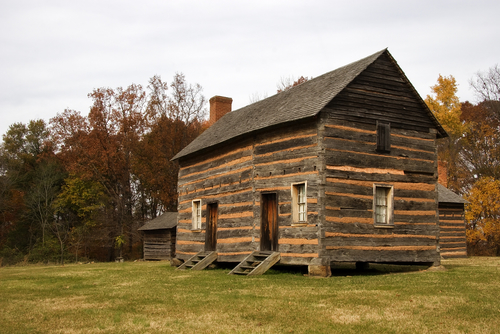
The career of the man who became
our eleventh President reflects the nationís commitment to westward
expansion.
At the age of ten, Polk moved with
his family across the Appalachian Mountains, to Tennessee. Growing up
on the Tennessee frontier, he acquired a strong work ethic,
resourcefulness, and democratic ideals. Although as a youngster,
and being accustomed to the rigors of frontier life, he lacked
physical stamina. Near his seventeenth birthday, he needed surgery for
stones in his urinary bladder, necessitating surgery. The operation
was a success, which enabled him to pursue an education with renewed
enthusiasm.
After only two and a half years of formal schooling in Tennessee, Polk
was admitted to the University of North Carolina as a sophomore. His
college studies and his membership in a debating society helped
nurture his growing interest in law and government. He graduated with
top honors in mathematics and the classics, and returned to Tennessee
to become a lawyer. To receive the legal training needed, he worked in
the office of renowned Nashville trial attorney Felix Grundy, and
served as clerk of the Tennessee Senate. Diligent and ambitious, James
soon established a law practice in Columbia, Tennessee.
Attaining early professional
success, he then turned his attention to politics. At the age of 27,
he ran for and defeated an incumbent for a seat in the Tennessee
Legislature. While serving as a State Representative, he began
courting Sarah Childress, the daughter of a prominent Murfreesboro
merchant and planter, and who he would eventually marry. Sarah was an
educated lady whose intellect and social grace impressed
contemporaries and she became her husband=s personal and political
confidante. Her active involvement in her husband's campaigns helped
ensure his victories.
Through his support of the policies of fellow Tennessee Democrat
Andrew Jackson, Polk was elected to the U.S. Congress at the age of
29. He enjoyed a long Congressional career that lasted 14 years that
included two terms as Speaker of the House.
Working in Washington, he remained profoundly interested in state
politics. Because of his concern that the Whig Party was becoming
increasingly popular in Tennessee, he returned home and successfully
ran for the governorship. Following his one two-year term, he failed
twice in his reelection attempts. Because of this, his rivals assumed
that his political influence and career was over, however; Polk stayed
active in Democratic politics and shrewdly sought opportunities to
revive his career.
The 1844
Election and the Presidency
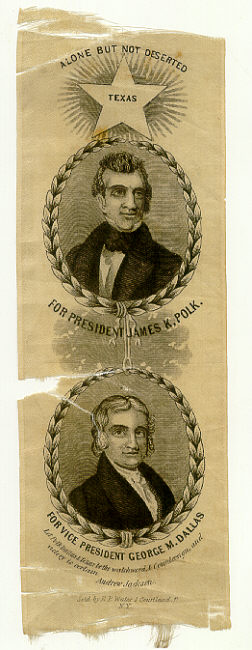
In
spite of Polk's political frustrations in Tennessee in the 1840s and
his failure at reelections, nationally prominent Democrats had not
forgotten his partisan dedication. Delegates to the 1844 Democratic
Convention viewed him as a possible vice president. When the party's
leading Presidential contenders Martin Van Buren and Lewis Cass failed
to attract sufficient support to win the nomination, the deadlocked
convention needed a compromise candidate. The Democrats'
"dark
horse" nominee was James K. Polk.
Challenging the well-known Whig
candidate Henry Clay in the 1844 Presidential election, Polk promised
to actively encourage America's westward expansion. He favored Texas
statehood and the acquisition of the Oregon Territory. Although
critics expressed concern that aggressive expansionism might lead to a
war with Great Britain or Mexico and might destroy the flimsy balance
between Free states and slave states, the majority of Americans
accepted Polk's vision of a continental nation.
Using his political magnetism and
savvy, President Polk tirelessly pursued his aspiring goals.
Negotiations with Great Britain, once very tense, concluded with
America's
annexation of the Oregon Territory south of the 49th Parallel.
Following a controversial two-year war, Mexico ceded New Mexico and
California to the United States. During Polk's term of office, the
United States acquired over 800,000 square miles of western territory
and extended its boundary to the Pacific Ocean. The Polk
Administration also achieved economic objectives by lowering tariffs
and establishing an independent Federal Treasury.

Polk remained steadfast to his
campaign pledge to serve only one term as President, and left office,
returning to Tennessee in March 1849. The nation's expansionist aims
had been realized. When Polk died of cholera three months later on
June 15, thousands of Americans were rushing west in search of
California gold. Polk is buried at the State Capital Grounds in
Nashville, Tennessee.
Sarah Childress Polk
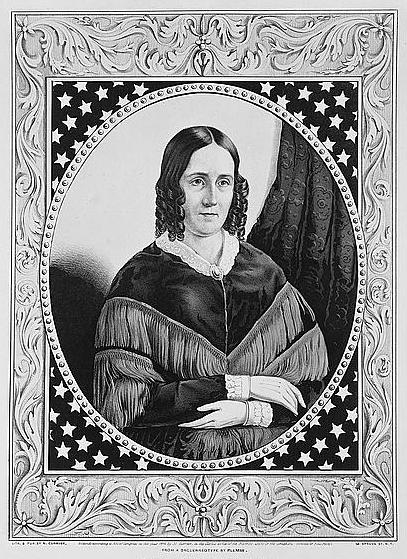
The woman who became first lady was
born in Rutherford County, Tennessee, the third of six children.
Although raised in the rugged Western Frontier, Sarah grew up amidst
wealth and refinement. Her father, Joel Childress, was a successful
businessman and planter.
While an education was unusual for
frontier girls, Sarah attended a local school and, in 1817, was sent
to Salem Academy in North Carolina, considered one of the best in the
South. The unusually strong curriculum included English grammar, Bible
study, Greek and Roman literature, geography, music, drawing, and
sewing. Sarah's education was cut short, however, by the death of her
father.
While James K. Polk was a Tennessee
Legislator, he began courting Miss Childress, and on January 1, 1824,
James and Sarah were married at her parents' home near Murfreesboro,
Tennessee. The young couple moved to a cottage in Columbia, where Mr.
Polk could concentrate on his law practice and political career.
Sarah's education would serve both her and her politically ambitious
husband well. As James embarked upon his long national political
career, Sarah acted as his secretary by keeping her traveling husband
aware of local political events. Because of her ability to
intelligently converse about politics, she was respected and
befriended by some of the great politicians of the day.
As First Lady, Sarah soon endeared
herself to the country. She was a strict Presbyterian, and changed the
image of the President's House by curbing the tradition of heavy
drinking and dancing at White House social functions. In charge of
completely remodeling the State floor of the President's House, she
created an elegant setting befitting the highest office in the land.
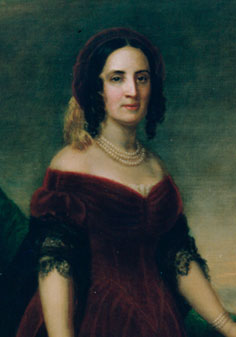
Following her four years there,
Sarah looked forward to her husband's retirement where they could live
quietly in their new home, Polk Place, in Nashville. Their quiet
retirement did not last long, however, as her husband died just three
months after leaving Washington. A 45-year-old widow, Mrs. Polk
donned the black clothes of mourning for the rest of her life. Not
long after her husband's
death, she became the guardian of an orphaned great niece. This
"adopted" daughter, Sally Polk Jetton, would remain with Sarah for the
rest of her days. Mrs. Polk was honored at Polk Place throughout her
life, and was considered the "grande
dame"
of Nashville for more than four decades. Following a short illness,
Sarah Polk died at Polk Place in 1891, just short of her 88th
birthday.
Sarah Polk in 1845-1849, is credited with starting the use of the song
"Hail to the Chief" as the Presidential Anthem, and in 1877 was given
the first telephone in Nashville. In 1888, Sarah was given the
honor of turning on the first electric lights in Cincinnati, Ohio.
The Polk
Ancestral Home
The
James K. Polk Ancestral Home in Columbia, Tennessee is the only
surviving residence of Polk (excluding the White House). Samuel Polk,
a prosperous farmer and surveyor, built the Federal-style brick house
in 1816 while his oldest son James was attending the University of
North Carolina. When the future President graduated in 1818, he
returned to Tennessee and stayed with his parents until his marriage
to Sarah Childress in 1824. While living in his family's Columbia
home, James practiced law and began his political career by
successfully running for the State Legislature. Today, the home
displays original items from James K. Polk's years in Tennessee and
Washington, D.C., including furniture, paintings, and White House
china.


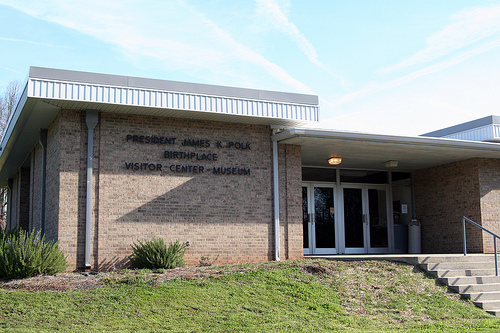
In addition to touring the main
home, guests may visit the adjacent ca. 1820 Sisters' House where two
of the President's married sisters lived at different times. The
Sisters' House offers a 12-minute orientation video, a museum room,
temporary exhibits, and a shop. The museum features some of the most
unique and significant artifacts from the site's collections including
daguerreotypes of President and Mrs. Polk, White House gifts and
mementos, campaign memorabilia from the Election of 1844, and Sarah
Polk's Inaugural fan with miniature portraits of the first eleven
Presidents.
The Polk home's detached kitchen
building was reconstructed in 1946 on the original foundation. Visitor=s
to the kitchen may see period cooking implements and household
accessories, and demonstrations of early 19th century crafts and
chores are presented here from time-to-time.
Although James K. Polk's final residence - a mansion in downtown
Nashville - was torn down in 1900, a cast iron fountain from the
property has been preserved and is displayed in the Polk home's
courtyard. The site's landscaped grounds feature a formal boxwood
garden, a white azalea garden, and a wildflower garden.
Quick
Biographical Facts
JAMES
KNOX POLK
11th President
Term- March 4, 1845 to March 4,
1849
Democratic Party

Birth: Pineville, Mecklenburg
County, North Carolina, November 2, 1795.
Ancestry: Scotch-Irish
Marriage: Murfreesboro, Tennessee,
January 1, 1824 to Sarah Childress, who was born in Murfreesboro,
Tennessee, September 4, 1803. Sarah died in Nashville,
Tennessee, August 14, 1891 and is buried at Capital Hill, Nashville,
Tennessee.
Children: None
Home: "Polk Place," Columbia,
Tennessee.
Education: Private school; received
B.A. from the University of North Carolina.
Religion: Presbyterian
Occupation before Presidency:
Lawyer
Pre-Presidential Offices: Member of
Tennessee Legislature; U.S. Representative; Speaker of the House of
Representatives; Governor of Tennessee.
Age at Inauguration: 49
Polk Administration: Vice
President: George M. Dallas of Pennsylvania, Inauguration March 4,
1845, The Capitol, Washington, D.C.
Occupation after Presidency:
Retired
Death: Nashville, Tennessee, June
15, 1849
Cause of Death: Cholera at age 53.
Place of Burial: State Capital
Grounds, Nashville, Tennessee.


Interesting Facts:
The promise of easy riches brought
thousands to California in the gold rush of 1842. In 1846, "Polk's
war" won the territory
from Mexico. Polk was cold, forbidding, and generally unpopular,
however; his support for manifest destiny, the idea that gaining
western lands was noble and right, resulted in the greatest
territorial expansion in America's history.
Just as Andrew Jackson's toughness
earned him the nickname "Old Hickory," Polk's support of Jackson was
so strong that he was nicknamed "Young Hickory," and won Jackson's old
seat in Congress eight times.
27th star added to the flag for
Florida, July 4, 1845
United States Naval Academy opened
at Annapolis, Maryland, October 10, 1845
Texas becomes the 28th state,
December 29, 1845
Uniform election day established,
January 23, 1846
War declared against Mexico, May
13, 1846
First known baseball game played
under rules established by Alexander Cartwright, at Elysian Fields,
Hoboken, New Jersey, June 19, 1846
Treaty concluded with Great Britain
establishing the Oregon boundary at the 49th parallel, June 15, 1846
Independent Treasury Act approved
August 6, 1846
Smithsonian Institute created
August 6, 1846
Elias Howe patents the sewing
machine, September 10, 1846
Rotary printing press invented
1845-1846
Treaty signed with New Grenada
(Colombia) granting U.S. right of way across Isthmus of Panama,
December 12, 1846
Iowa becomes the 29th state,
December 28, 1846
Postage stamp authorized by Act of
Congress, March 3, 1847
Congress provided for gas lighting
of the Capitol and grounds, March 3, 1847
An advance party of Mormons entered
the valley of the Great Salt Lake, July 22, 1847
Gold discovered in California,
January 24, 1848
Treaty signed with Mexico, February
2, 1848
Wisconsin becomes the 30th state,
May 29, 1848
Cornerstone of the Washington
Monument laid, July 4, 1848
First Women's Rights Convention
held at Seneca Falls, New York, July 19, 1848
Territorial government of Oregon
established, August 14, 1848
Department of the Interior created
March 3, 1849
Coinage of the gold dollar and
double eagle ($20), March 3, 1849

Copyright © 1992-2022 by John T. Marck.
Grateful appreciation and informational assistance in part from The
Polk Ancestral Home, Columbia, Tennessee. Additional information
from
"Homes
and Libraries of the Presidents,"
by William G.
Clotworthy, The McDonald & Woodward Publishing Company, Blacksburg,
Virginia, 1995 and
"The
Presidents of the United States,"
by John T. Marck.
A
Splendid Time Is Guaranteed For All
| | |
| |

